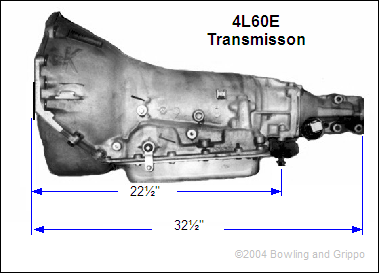

The 4L60E is an electronically shifted General Motors RWD 4-speed automatic transmission. MegaShift is an electronic controller for this transmission that is based on the MegaSquirt® GPIO hardware.
The GM 4L60E 4-speed Automatic RWD Transmission
The basis for 4L60E rear wheel drive transmission was introduced in Chevrolet cars and trucks in 1982 as the 700R4 overdrive-equipped replacement for the TH350. Originally, only the torque converter was computer controlled.
Just for a bit of background, the 700R4 was one of the first overdrive transmissions, and it coincided with two other developments: lock-up converters, and EFI.
EFI was necessary because carbs typically won't meter well at the low cruise rpms and relatively high manifold pressure (low vacuum) that an overdrive transmission allows (around 1500 rpm at legal highways speeds in 4th (OD)). EFI allows the fuel to be precisely metered at any speed/load - if tuned properly, allowing lower rpms and higher manifold kPa. This meant less frictional losses (lower speed) *and* less pumping losses (higher MAP) *and* better combustion efficiency (higher combustion pressures because the higher MAP allows better cylinder filling so this is a bit like a compression rise).
The lock-up torque converter (sometimes called the TCC for torque converter clutch) was necessary with overdrive because if a non-lock-up torque converter is operated below it's 'stall speed' for long periods of time, the slippage will heat the transmission fluid, possibly excessively. But lowering the stall speed to less than 1500 rpm would make the car a 'dog' off the line. So by having a lock-up converter, you can have a decent stall, but still lock it up while cruising to prevent excessive heating.
The common reasoning is that the lock-up improves mileage because it reduces the slippage, but this is a minor effect. Instead it's primarily there to allow sub-stall rpms without overheating the transmission fluid.
These three things (EFI, overdrive transmission, and lock up converters) combined with the EGO sensor to make for a new era in engine developments that has resulted in the return of performance while achieving very good mileage and low emissions (remember when everyone thought the muscle cars of the 1960 and early 1970s were going to be the high watermark for horsepower forever?).
There were frequent improvements to the 700R4 through it's life. Early versions had weak 27 spline input shafts, but these were upgraded to a larger 30 spline shaft in 1984. Many other minor improvements were made, almost every year, and generally the later the transmission the better it is.
Later editions of the 700R4 were renamed the 4L60, and the fully electronically controlled version (the 4L60E) became available in 1992. When the Corvette went to a rear transmission location in 1997, the case of the 4L60E was redesigned with a removable bell housing, and this was offered in all subsequent uses of the transmission. The internal components remained interchangeable, though.
The 4L60E's principal feature is a 30% overdrive. It also sports a low first gear ratio of 3.06:1 for improved acceleration 'off the line'. These transmissions are quite strong and reliable. Earlier models can be improved by the stock upgrades, and can be greatly improved with many aftermarket parts and building techniques.

| Case to Extension Housing | Overall Length | Bellhousing to Trans Mount |
| 23 3/8" | 32 1/2" | 22 1/2" |
| Transmission | 1st Gear | 2nd Gear | 3rd Gear | 4th Gear OD |
| TurboHydramatic 350 | 2.52 | 1.52 | 1.00 | N/A |
| TurboHydramatic 400 | 2.48 | 1.48 | 1.00 | N/A |
| 2004R | 2.74 | 1.57 | 1.00 | 0.67 |
| 700R4/4L60/4L60E | 3.06 | 1.63 | 1.00 | 0.70 |
| 4L80E | 2.48 | 1.48 | 1.00 | 0.75 |
For those upgrading from a 700R4 to a 4L60E, the differences are primarily:
4L60E Shift Logic
The following table illustrates the hardware logic required to shift gears in the 4L60E. Note that the transmission can be electronically shifted between the 4 forward gears, neutral, park, and reverse must be selected with the shift lever (though the shift lever position can be detected via the switch manifold feedback). Once in Drive, the transmission's forward gears can be controlled with MegaShift.
The table gives the state of transmission's inputs and outputs for each gear, as well as what needs to change during upshifts and downshifts.
| Gear | SOL A | SOL B | 3/2 SOL | PC | LED1 | LED2 | LED3 | LED4 |
| Reverse | on | on | off | PWM% based on load | flash | flash | flash | flash |
| Neutral/Park | on | on | off | off | off | off | off | |
| 1 | on | on | off | PWM% based on load | on | off | off | off |
| 1/2 upshift | switch off | on | sw 90%PWM | PWM% based on load | switches on | sw on | off | off |
| 2/1 downshift | switch on | on | sw off | PWM% based on load | on | sw off | off | off |
| 2 | off | on | 90% PWM | PWM% based on load | on | on | off | off |
| 2/3 upshift | off | switch off | 90% PWM | PWM% based on load | on | on | sw on | off |
| 3/2 downshift | off | switch on | PWM reduced | PWM% based on load | on | on | sw off | off |
| 3 | off | off | 90% PWM | PWM% based on load | on | on | on | off |
| 3/4 upshift | switch on | off | 90% PWM | PWM% based on load | on | on | on | sw on |
| 4/3 downshift | switch off | off | 90% PWM | PWM% based on load | on | on | on | sw off |
| 4 | on | off | 90% PWM | PWM% based on load | on | on | on | on |
Gear Lever Position
Switch A
(Input1)
Switch B
(Input2)
Switch C
(Input3)
Park/Neutral
High
Low
High
Reverse
Low
Low
High
1st
Low
High
High
2nd
High
High
High
3rd
High
High
Low
4th
High
Low
Low
Note that Switch A, Switch B, and Switch C indicate the position of the manual valve (the shift lever, in essence). This tells MegaShift when the transmission shift lever is at park/neutral, reverse, D1, D2, D3, or D4. The values for the switch manifold shown above indicate manual valve position, NOT the currently selected gear. The switch manifold information is used to limit upshifts, where desired. Note that engine braking (via the overrun clutch in the transmission) is only available when the manual valve is in position D3, D2, D1.
Shifting Strategies
So the basic shift strategy looks like this:
Steady State Monitoring Configuration
Reverse
Neutral/Park
First
Second
Third
Fourth
Torque Converter Clutch
Shift 'Mechanism'
This is the basic operation of the shift in sequential mode. (The code also has the capability to go direct to a commanded gear, skipping intervening gears.)
* Upshifts *
First-Second
Second-Third
Third-Fourth
* Downshifts *
Fourth-Third
Third-Second
Second-First
Note that shifting the transmission using the shift solenoids versus shifting it using the manual lever has 2 effects: